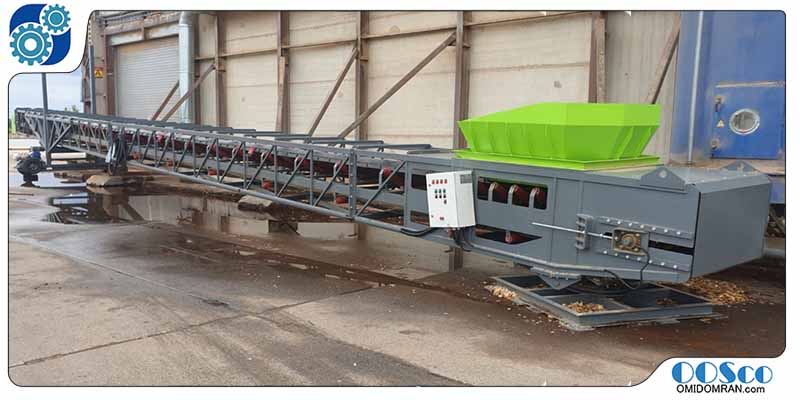Ship loading conveyor
?What is ship loading conveyor
Ship loader conveyors are a type of conveyor system that are designed to load bulk materials, such as coal, grain, ore, loading food materials, loading chemical materials, loading dry goods or loading liquid goods onto ships for transportation. They are an essential part of any modern port facility, and are used to transfer large quantities of material quickly and efficiently from storge facilities to waiting ships.
There are several different types of ship loader conveyors, each with their own unique advantages and disadvantages. The most common type is the belt conveyor, which uses a continuous belt to move materials from the storage facility to the ship. belt conveyors are simple and reliable, and can handle a wide variety of materials, but they can be prone to material spillage and require regular maintenance.
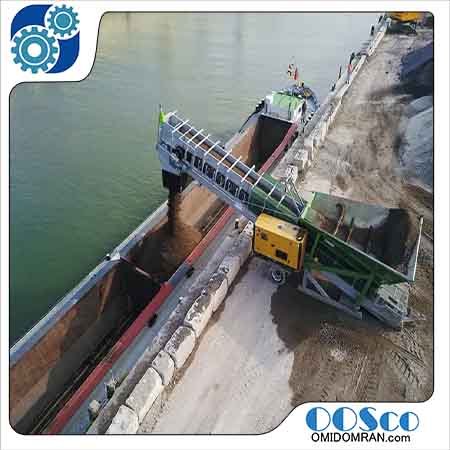
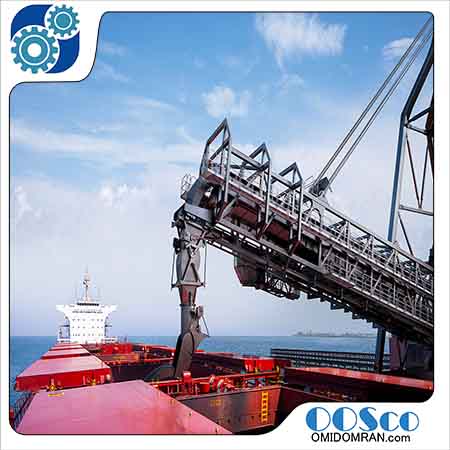
Types of ship loading conveyors
Loading ship Conveyor
Loading cargo onto a ship often involves the use of conveyor belts, which transport goods from shore to the vessel. These loading conveyor belts play a critical role in the loading process, as they allow for efficient and speedy transfer of cargo. However, conveyor belt fires during loading operations can pose a significant safety risk. These fires can be caused by a variety of factors, such as friction between the belt and the cargo, electrical faults, or overheating of the belt. To prevent conveyor belt fires during loading operations, it is important to conduct regular inspections and maintenance on the equipment. This may include checking for worn or damaged components, ensuring that the belt is properly lubricated, and monitoring the temperature of the belt to prevent overheating. Additionally, workers should receive training on safe loading procedures and emergency response in the event of a fire. This may include having fire suppression equipment readily available and establishing evacuation protocols. By taking these steps, cargo can be loaded safely and efficiently onto ships using conveyor belts.

Important points in using the ship loading conveyor
However, there are also some considerations to keep in mind when using a ship loading conveyor for ship loading. For example, the conveyor may need to be designed with specific weight capacity and size limitations to ensure that it can effectively transport materials onto the ship. Additionally, proper safety measures should be in place to prevent accidents or injuries to personnel working in the vicinity of the conveyor. Overall, a ship loading conveyor can be a viable option for ship loading, but it is important to carefully consider the specific requirements and limitations of the application before selecting this type of equipment.
Important items in the structure of the ship loading conveyor
A ship loading conveyor is a specialized conveyor system used to transport bulk materials such as grains, coal, and ores from the dock or storage facility to the ship’s cargo hold. The conveyor must be designed to handle the specific material being transported, and it must also be capable of withstanding the harsh marine environment.
One important property of a ship loading conveyor is its capacity. The conveyor most be be able to transport the required amount of material in a timely and efficient manner. The capacity of the conveyor will depend on factors such as the size of the ship, the distance between the dock and the ship, and the type of material being transported.
Another important property of a ship loading conveyor is its durability. The conveyor most be able to withstand the harsh marine environment, which includes exposure to slat water , wind , and corrosion. The conveyor must be made of materials that are resistant to corrosion and erosion, such as stainless steel or high-density polyethylene.
✅ In addition, the conveyor must be designed to operate reliably in all weather conditions. It must be able to handle high winds, heavy rain, and extreme temperatures without experiencing downtime or damage.
Finally, the ship loading conveyor must be designed with safety in mind. It must be equipped with safety features such as emergency stop buttons and guards to prevent workers from coming into contact with moving parts. It must also be designed to prevent material from spilling over the sides of the conveyor and into the water.
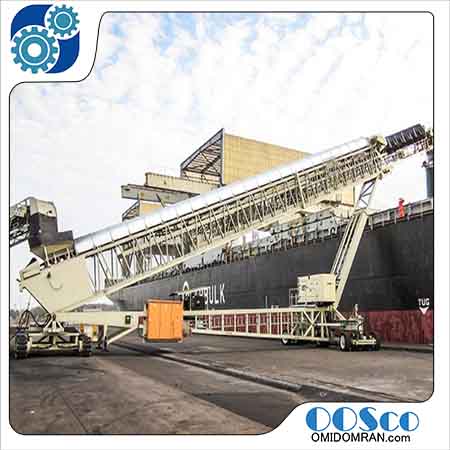
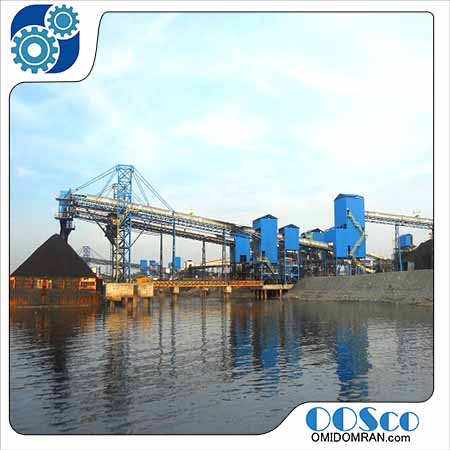
Ship loading Conveyor features
The Following are some features of ship loading conveyor:
Adjustable height: The conveyor system can be adjusted to be the height of the ship’s cargo hold to ensure that the material is loaded efficiently.
Variable speed: The conveyor’s speed can be adjusted to ensure that the material is loaded at the correct rate and to prevent spillage.
Multiple loading points: The conveyor can have multiple loading points, allowing several trucks or storage bins to discharge simultaneously.
Dust control: Dust control measures can be incorporated to reduce the amount of dust produced to reduce the amount of dust produced during loading.
Automated controls: he conveyor can be automated using computer controls, making it easier to operate and reducing the need for manual intervention.
Weather protection: The conveyor can be designed with weather protection features, such as covers or enclosures, to protect against rain, wind, or extreme temperatures.
Mobility: Some ship loading conveyors can be mounted on wheels or tracks, allowing them to be easily moved around the dock or storage facility.
Corrosion-resistant materials: Ship loading conveyors are often made from corrosion-resistant materials, such as stainless steel or aluminum, to withstand exposure to salt water.
Safety features: The conveyor can be equipped with safety features such as emergency stop buttons, safety guards, and warning lights to prevent accidents.
Easy maintenance: The conveyor can be designed for easy maintenance, with features such as removable belt sections and access panels for cleaning and repairs.
Repair and maintenance of ship loader conveyor
Repair and maintenance of ship loader conveyor involves several steps, including inspection, troubleshooting, and repairs. Here is an overview of the steps involved:
Inspection: The first step is to inspect the conveyor system thoroughly to identify any areas that require repair or maintenance. Inspect the belts, rollers, pulleys, and any other components of the system.
Troubleshooting: Once you have identified the areas that require repair or maintenance, you need to troubleshoot the issues. This involves identifying the root cause of the problem and determining the best way to fix it.
Repairs: After identifying the issues and determining the best course of action, you can proceed with the repairs. This may involve replacing or repairing components of the conveyor system, such as belts, rollers, pulleys, motors, or bearings.
Preventive Maintenance: To avoid breakdowns and extend the life of the conveyor system, it’s important to perform regular preventive maintenance. This includes tasks such as cleaning the system, lubricating moving parts, and checking for signs of wear and tear.
Testing and Calibration: After completing the repairs and preventive maintenance, it’s important to test the conveyor system to ensure it’s functioning correctly. Calibration of the system is also essential to ensure accurate and consistent performance.
It’s important to follow manufacturer guidelines and safety protocols when repairing and maintaining ship loader conveyors. If you’re not experienced in this type of work, it’s recommended to seek the assistance of a professional technician or company with expertise in conveyor systems.
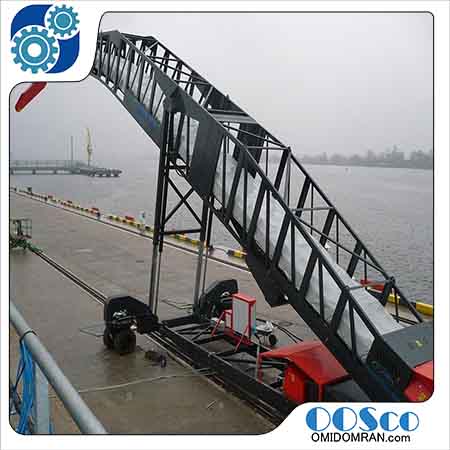
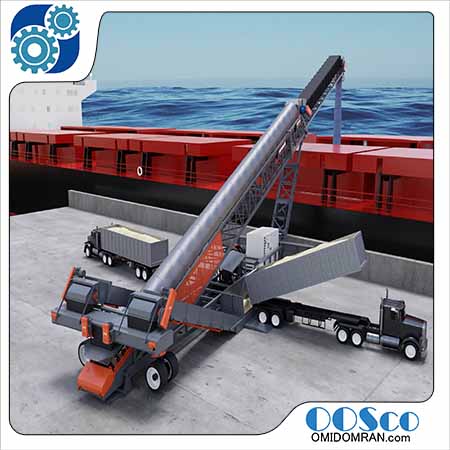
Steps involved in loading a ship with a ship loading conveyor
Loading a ship with a conveyor requires a series of steps that ensure safe and efficient transfer of the material. Here are the steps involved in loading a ship with a ship loading conveyor:
Preparation: Before loading, ensure that the conveyor is in good working condition and that it is properly positioned to reach the ship’s hold. Also, ensure that the ship is properly moored to the dock to prevent it from drifting away.
Positioning: Position the conveyor in such a way that it can reach the ship’s hold. The conveyor should be positioned at an appropriate height and angle to ensure that it can discharge the material efficiently into the hold.
Loading: Start loading the material onto the conveyor. This can be done using a front-end loader or other types of loading equipment. Ensure that the material is loaded onto the conveyor evenly to prevent spillage.
Control: Once the conveyor is running, control the speed of the conveyor to match the ship’s hold’s capacity. This helps to prevent overloading or under-loading of the hold, which can cause instability.
Operation: As the conveyor discharges the material into the hold, make sure that the material is evenly distributed across the hold. This can be achieved by adjusting the conveyor’s height and angle to ensure even discharge of the material.
Monitoring: Throughout the loading process, monitor the conveyor’s operation to ensure that it is functioning correctly. Also, keep an eye on the hold’s filling level to prevent overloading.
Completion: Once the hold is full, stop the conveyor and ensure that all the material has been discharged from the conveyor. Disconnect the conveyor from the ship and dock, and then clean up any spillage that may have occurred.
In summary, loading a ship whit a ship loading conveyor requires proper preparation, positioning, loading, control, operation, monitoring, and completion to ensure a safe and efficient transfer of the material.
Telescopic conveyor
A third type of ship loader conveyor is the telescopic conveyor, this is commonly used for loading and unloading goods onto ships. Here we write some important points to consider when using a telescopic conveyor for ship loading:
Choose the right type of telescopic conveyor: There are different types of telescopic conveyors available in the market. Choose the one that suits your specific requirements. For ship loading, a telescopic conveyor with a wide conveyor belt and adjustable height is usually preferred.
Proper installation: Ensure that the telescopic conveyor is installed correctly and securely. It should be level and aligned with the ship’s loading area to avoid any accidents or product damage during loading.
Material handling: Choose the appropriate telescopic conveyor for the material being handled. The size, weight, and fragility of the product should be taken into consideration. For ship loading, the telescopic conveyor should be able to handle the weight and size of the products being loaded.
Capacity: Determine the capacity of the telescopic conveyor needed for loading. This will depend on the amount of product being loaded and the speed at which it needs to be transported.
Safety: always fallow safety protocols when operation the telescopic conveyor. Ensure that all guards and safety device are in place and functioning properly. Operators should be trained on how to operate the equipment safely.
Maintenance: Regular maintenance is essential for keeping the telescopic conveyor running smoothly. Check the chain, bearings, and motors for wear and tear, and replace and damaged components immediately.
Integration with other equipment: he telescopic conveyor should be properly integrated with other equipment in the loading area. This will ensure that there is a smooth flow of product from the conveyor to the ship.
Space requirements: Consider the space requirements when installing a telescopic conveyor. It should be placed in an area where there is enough room for the equipment and for operators to safely work around it.
Cost: Consider the cost of purchasing and operating a telescopic conveyor. It may be more expensive than other types of conveyors, but its benefits in terms of efficiency and space savings may outweigh the cost.
Regardless of the type of ship loader conveyor used , the key to their success is their ability to handle large volumes of material quickly and efficiently. This requires careful planning and design , including considerations such as the size and shape of the storage facility , the size and capacity of the ship, and the type of material being transferred.
In addition, safety is a critical concern when it comes to ship loader conveyors. these system can be dangerous if not properly maintained and operated, and can pose a risk to workers and the environment. It is important to follow strict safety guidelines and protocols , and the ensure that all equipment is properly maintained and inspected.
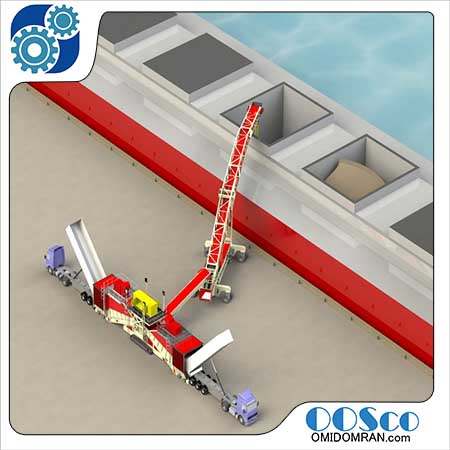
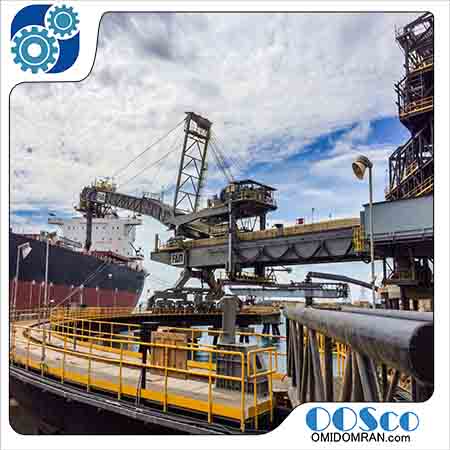
conclusion
In conclusion, ship loader conveyors are a vital component of modern port facilities, and are essential for transporting bulk materials from storage facilities to waiting ships. They come in a variety of types, each with their own unique advantages and disadvantages, and require careful planning and design to ensure their success. Safety is also a critical concern, and must be taken seriously to prevent accidents and protect workers and the environment.
OSS ship loader
If you’re looking to purchase a conveyor belt for loading ships, We would recommend checking out the products offered by “Omid Omran Sahand” company. We are a reliable manufacturer of conveyor belts and offer high-quality products for various industries. To purchase a conveyor , you can contact our sales team and provide us with your specific requirements such as the length, width, and capacity of the conveyor . We will be able to provide you with a quote and guide you through the purchasing process. It’s always important to do your research and choose a reputable manufacturer when making a significant purchase like this. I hope this information helps, and good luck with your purchase!
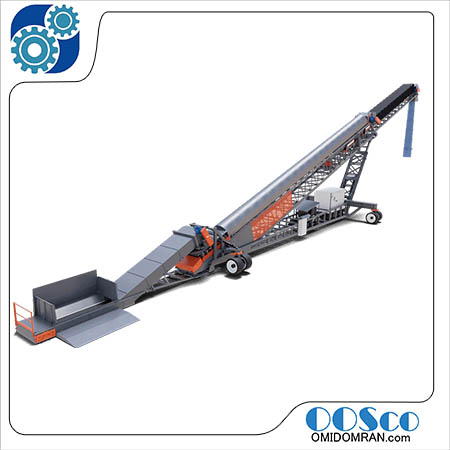
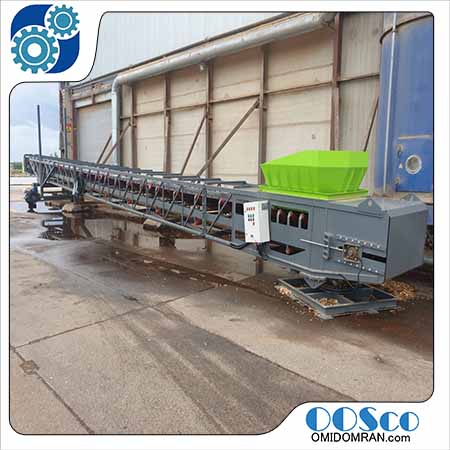
How to order ship loading conveyor from Omid Omran Co
To order a ship loading conveyor from Omid Omran Sahand Company, you can follow these steps:
Determine your needs: First, determine the type of material that you need to load onto the ship and the amount of material that needs to be loaded. This information will help you to choose the appropriate type and size of the conveyor.
Contact Omid Omran Sahand Company: You can contact the company by visiting our website or by calling our customer service. We will provide you with the necessary information about their products and services and answer any questions you may have.
Provide specifications: Provide Omid Omran Sahand Company with the specifications of the ship loading conveyor you need. This should include the size, capacity, and any specific requirements for the conveyor.
Request a quote: Once the specifications have been provided, Omid Omran Sahand Company will provide you with a quote for the ship loading conveyor. The quote will include the price of the conveyor, delivery time, and any other related costs.
Place an order: If you are satisfied with the quote, you can proceed to place an order. Our company will provide you with an order confirmation and delivery schedule.
Delivery and installation: Once the ship loading conveyor is ready, it will be delivered to your location. The company will provide installation services or guidance to ensure that the conveyor is properly installed and functioning correctly.
Training and support: Omid Omran Sahand Company will provide training on how to operate and maintain the ship loading conveyor. We also offer support services in case of any issues that may arise with the conveyor.
In summary, ordering a ship loading conveyor from Omid Omran Sahand Company involves determining your needs, contacting the company, providing specifications, requesting a quote, placing an order, delivery and installation, and training and support. The company offers high-quality products and services to ensure that your needs are met.
Ready to cooperate with all countries
Omid Omran Sahand Company understands the importance of international cooperation and believes that working with foreign countries can help to expand our reach and bring new opportunities for growth and development. We are open to partnerships and collaborations with companies from all over the world. If you are interested in working with Omid Omran Sahand Company, you can contact us through our website or by email. We will be happy to discuss the details of potential collaborations and explore how our can work together to achieve mutual benefits.
